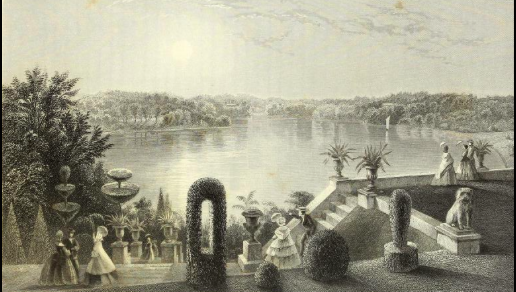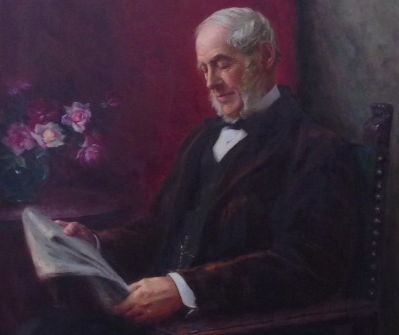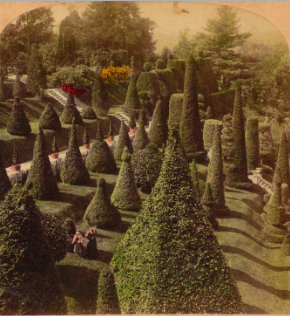The Hunnewell Estate: Wellesley
It’s not often that I visit private gardens and even less often that I visit those best known for their topiary (despite the fact that I wrote about the Ladew Topiary Gardens in my last post).
However, when I discovered that Tower Hill Botanic Garden was offering a tour of the Hunnewell Estate in Wellesley I decided to attend, having admired its picturesque front lawn and entry drive on my visits to Elm Bank, home of the Massachusetts Horticultural Society which is just across the road.
The estate is a rare, surviving example of its type; a comprehensive ensemble created and owned by the same family for more than one hundred and fifty years. Once regaled as a fine example of a model country place in the style of A.J. Downing, it has retained its design integrity and remarkable collection of trees. Visiting was a special treat.
Described in a New England Historical Society article as a “railroad baron and garden nut,” Horatio Hollis Hunnewell was born in 1810 and began work on his estate in Wellesley in the 1840s. Enamored of rural life, Hunnewell spent decades planning, planting, expanding and improving the property.
In 1854, three years after the house, designed in the renaissance revival style by architect Arthur Gilman was built, Hunnewell began work on the Italian garden. Containing a series of seven terraces on a seventy-five foot bluff overlooking Lake Waban, it was inspired by the gardens at Elvaston Castle in Derbyshire, England.
Since the time of Pliny the Elder (1st century AD) topiary, the art of shaping trees and shrubs, has been practiced in various forms. Hunnewell’s use of topiary in his Italian garden is credited with being the earliest in the United States and the geometric shapes he favored were executed with species of trees cross-bred to thrive in New England’s harsh climate.

Italian Garden and Lake at Wellesley near Boston, ca.1830 by JD Smillie for A Treatise on the Theory and Practice of Landscape Gardening, 8th edition by A.J.Downing.
Hunnewell’s Italian garden included a pavilion and a series of steps, ornamented with statuary and urns with a lakeside promenade. In 1865 Hunnewell built a boathouse to house an Italian gondola.
As far as topiary is concerned (and here I add that an expert I am not) Hunnewell favored geometrical shapes and forms including cones, spheres and pyramids rather than representations of birds and animals.
The image below, taken from a stereoscope by J.F. Jarvis is titled “The artist’s dream: Hunnewell’s grounds, Wellesley, MA., USA. It’s all rather pointy and looks rather like a cross between Alice in Wonderland and Dr. Seuss.
Maintaining topiary is a labor intensive task and at one time five men spent two months each year on ladders, held by hand to trim the trees in the Italian garden. Today this job is undertaken by the current garden staff with the assistance of family members.
Committed to the advancement of horticulture, Hunnewell had one of the largest and diverse collections of conifers in the United States. He was nationally recognized for his experiments with trees and woody plants including the now ubiquitous rhododendron, which he introduced to New England and sponsored an exhibition of on the Boston Common in 1873.
Befitting an operation of its scale, the Hunnewell estate included other gardens and features including a formal french style garden adjacent to the house (now removed). We had an opportunity to visit the conservatory where trained nasturtium vines encircle the doorway.
One cannot help but to be deeply impressed by the vision and dedication that Hunnewell brought to his horticultural pursuits. A lifelong supporter of both the Massachusetts Horticultural Society and the Arnold Arboretum, Hunnewell was a passionate advocate for both institutions. His strong sense of stewardship for the landscape and collections of his estate has been carried on by subsequent generations and today the property is protected with a conservation restriction by the Trustees of Reservations.
One last note on the name. The property was originally named Wellesley, in honor of Hunnewell’s wife’s family. When both the neighboring Wellesley College and the town, of which Hunnewell was a generous benefactor, adopted the name there was a bit too much “Wellesley” and it is now referred to as the Hunnewell Place/Estate/Property.
Please note that the Hunnewell Estate garden will be open to the public through the Garden Conservancy’s Open Days program on Saturday, August 13, 2016 from 10-2 pm.
Copyright © 2016 Patrice Todisco — All Rights Reserved




























Dear Patrice, I enjoy your blog, so it was a pleasure to read about the Hunnewell Estate in Wellesley just now. Would you be willing to add to your post that the garden will be open to the public through the Garden Conservancy’s Open Days program on Saturday, August 13, from 10-2? I am both the landscape curator at Innisfree Garden (where I get your blog) and the Director of Recruitment for Open Days at the Garden Conservancy.
Also on August 13, you might enjoy the special program at Ellen Lathi’s garden nearby in Needham, hosted by both Ellen and Kerry Ann Mendez at 2:00. Ellen’s garden will be open from 10-4. Here is all the information on events that day: https://www.gardenconservancy.org/events/all-events/greater-boston-ma-open-day-4 Thanks so much for the joy your great blog brings! All best,Kate Kerin
Thanks Kate, I’ve posted your email in the comment section and will also add a sentence to the end of the piece.
I often walk around Lake Waban. During this walk I walk right under the Hunnewell Estate’s topiaries. Many a time I have seen men pruning them. Such commitment and skill. I have topiary envy and often think I would have a topiary garden if I could be assured of finding a skilled craftsperson to prune them into shape. I am creating a Wave of boxwoods in the front of my house. The best view of the topiaries, IMHO, is across Lake Waban on Wellesley College Campus by their boathouse. Especially if the light is hitting the topiaries at the right time of day, the shadows are wonderful.
How fortunate that you intimately experience the Italian Garden on your walks around the lake. AS for your own topiary endeavors, good luck!